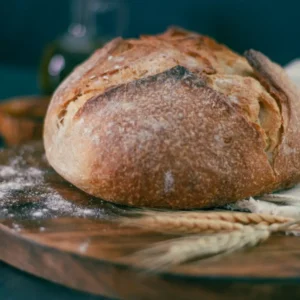
Sourdough Bread Recipe
Master the art of baking sourdough with this simple, step-by-step recipe! Whether you’re a beginner or experienced baker, this guide makes it easy to create a beautifully crusty, flavorful loaf right at home. With just a few ingredients and expert tips, you’ll be baking like a pro in no time. Download the recipe now and enjoy the satisfaction of making your very own sourdough bread!
Ingredients
- 500 grams All-purpose flour
- 350 grams Water (room temperature)
- 100 grams Active sourdough starter
- 10 grams Salt
Instructions
- Mixing the Ingredients: In a large bowl, combine the flour, water, and active sourdough starter. Use a wooden spoon or your hands to mix until all the ingredients are thoroughly combined, forming a rough, sticky dough. At this stage, there’s no need for extensive kneading; the goal is just to make sure all the flour is hydrated. This initial mixture allows the flour to absorb the water and starts the fermentation process.
- Resting and Fermentation: Cover the bowl with plastic wrap or a damp cloth and let it rest for several hours, ideally in a warm area. This resting period, also called the “bulk ferment,” allows the natural yeast in the sourdough starter to become active and start creating bubbles in the dough. You’ll know it’s ready for the next step when the dough has expanded and is filled with air bubbles, giving it a light, spongy appearance.
- Adding Salt and Kneading: Once the dough has developed some bubbles, add the salt. Then, begin kneading by hand or with a mixer. Knead the dough until it’s smooth and elastic, which may take about 5-10 minutes by hand. You’ll know the dough is ready when it becomes stretchy and starts to pull away from the bowl cleanly. This kneading process strengthens the gluten structure, essential for achieving a good rise and chewy texture.
- Shaping and First Rise: Shape the dough into a ball by pulling the edges toward the center and creating tension on the surface. Place the dough back into the bowl, cover it, and let it rise for several hours, or until it doubles in size. This stage can take anywhere from 3-6 hours, depending on room temperature. Allowing the dough to double gives it a lighter texture and further develops its flavor.
- Final Shaping and Proofing: Once doubled, gently reshape the dough into a round or oval shape, depending on your preference or the shape of your baking vessel. Place the shaped dough in a proofing basket, seam side up, to help it maintain its shape during the final rise. Cover it with a cloth and let it rest for another hour. This brief proofing period adds the final touch of lightness before baking.
- Preheating and Baking: Preheat your oven to 450°F (230°C) with a Dutch oven inside to ensure it’s thoroughly heated. Carefully transfer the dough onto a piece of parchment paper, then place it in the preheated Dutch oven. Cover with the lid and bake for 30-35 minutes. This method traps steam, which creates a crispy crust. For an even crustier finish, remove the lid during the last 10 minutes of baking.